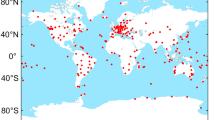Abstract
The BeiDou Navigation Satellite System is expected to provide a global positioning and navigation service by 2020. To achieve this goal, the new-generation navigation satellites that have been launched since March 2015 are equipped with inter-satellite links (ISLs), with the objective of testing new navigation signals and the ISLs themselves. Using these new-generation navigation satellites and several ground facilities in China, a combined orbit determination experiment was carried out during August 2016. The orbit mechanical model, orbit determination method, and accuracy evaluation method used in this experiment are presented here. The accuracy of the combined orbit determination method is evaluated, and the performance-related improvements resulting from the ISLs are analyzed. The performance of orbit determination has been increased about 37–76% for different satellites in orbit-only signal-in-space range error (orbit-only SISRE).











Similar content being viewed by others
References
Amarillo F (2011) Inter-satellite ranging and inter-satellite communication links for enhancing GNSS satellite broadcast navigation data. Adv Space Res 47(5):786–801
Fisher SC, Ghassemi K (1999) GPS IIF-the next generation. In: Proceedings of the IEEE. Seal Beach, CA, 1999, pp 24–47
Liu J, Geng T, Zhao Q (2011) Enhancing precise orbit determination of compass with inter-satellite observations. Surv Rev 43(322):333–342
Luba O, Boya L, Gower A, Crum J (2005) GPS III system operations concepts. IEEE Aerosp Electron Syst Mag 20(1):10–18
Maine K, Anderson P, Langer J (2003) Crosslinks for the next-generation GPS. IEEEAC 2003(4):1589–1595
Maine K, Anderson P, Bayuk F (2004) Communication architecture for GPS III. In: Proceedings of IEEE aerospace conference, Feb
Tang CP, Hu XG, Zhou SS et al (2016) Improvement of orbit determination accuracy for Beidou navigation satellite system with two-way satellite time frequency transfer. Adv Space Res 58(7):1390–1400
Tapley BD, Schutz BE, Born GH (2004) Statistical orbit determination 39(3):525–536
Wolf R (2000) Satellite orbit and ephemeris determination using inter satellite links. Faculty of Civil Engineering and Surveying, University of the Federal Armed Forces of Munich, Neubiberg
Xu HL, Wang JL, Zhan XQ (2012) Autonomous broadcast ephemeris improvement for GNSS using inter-satellite ranging measurements. Adv Space Res 49(2012):1034–1044
Yang DN, Yang J, Xu PJ (2016) Timeslot scheduling of inter-satellite links based on a system of a narrow beam with time division. GPS Solut. doi:10.1007/s10291-016-0587-0
Zhou SS, Cao YL, Zhou JH et al (2012) Positioning accuracy assessment for the 4GEO/5IGSO/2MEO constellation of COMPASS. Sci China Phys Mech Astron 55:2290–2299. doi:10.1007/s11433-012-4942-z
Author information
Authors and Affiliations
Corresponding author
Rights and permissions
About this article
Cite this article
Yang, D., Yang, J., Li, G. et al. Globalization highlight: orbit determination using BeiDou inter-satellite ranging measurements. GPS Solut 21, 1395–1404 (2017). https://doi.org/10.1007/s10291-017-0626-5
Received:
Accepted:
Published:
Issue Date:
DOI: https://doi.org/10.1007/s10291-017-0626-5




